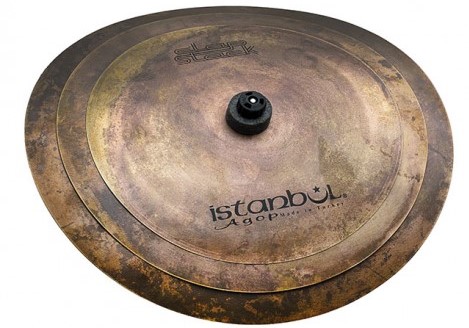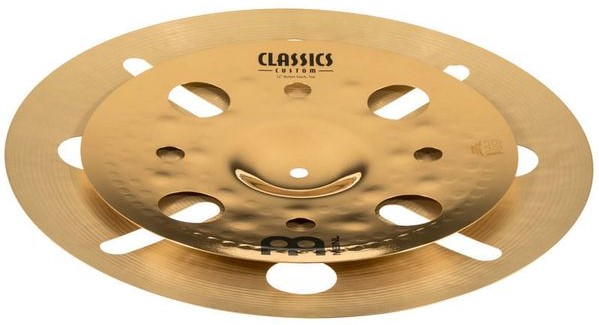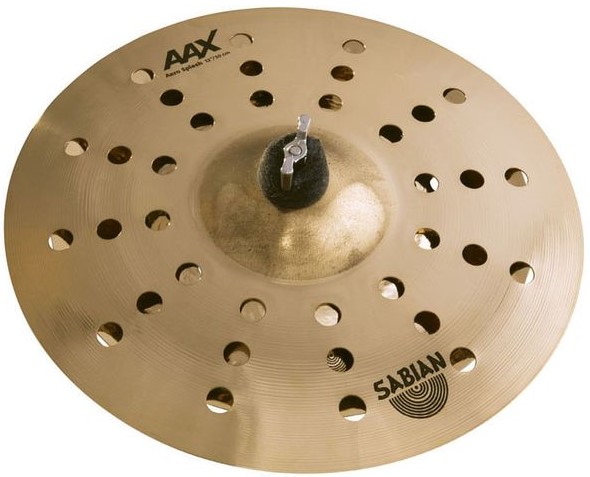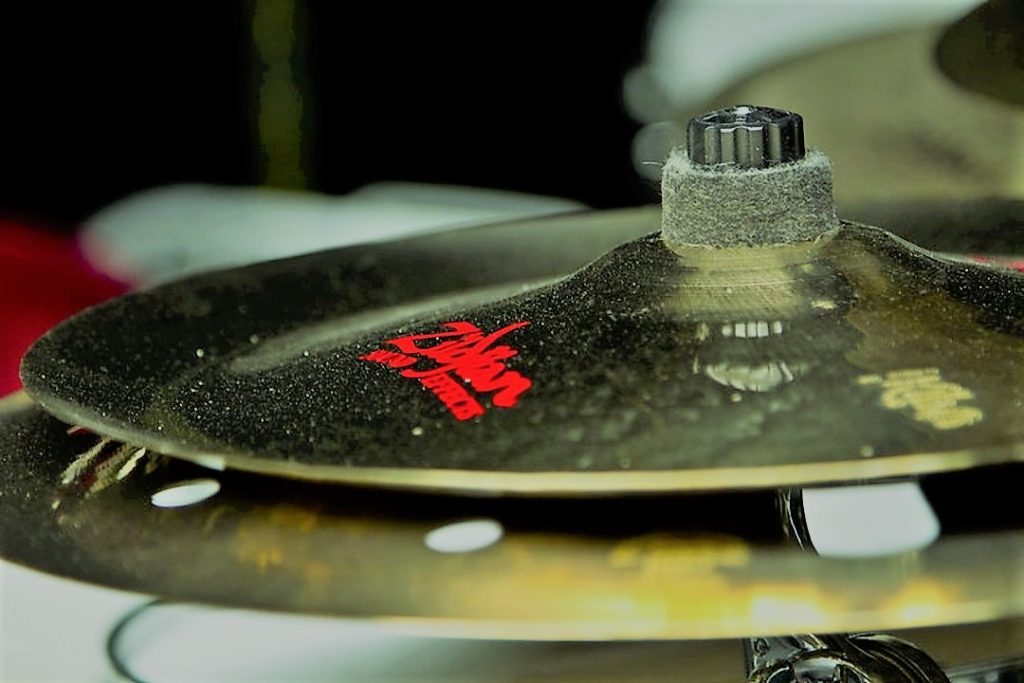Looking to add one of the best cymbal stacks to your arsenal? I haven’t played without a cymbal stack ever since I added my first one to the kit.
Of course, at the time, they weren’t as popular as they are today, so most drummers would stack their old, unused, and, more often than not, cracked cymbals to make a stack.
To clarify, you can still do it today, since it’s the best option if you’re looking for something unique, rather than sounding like everyone else.
On the other hand, if you don’t want to put too much thought into it, just buy one of the many cymbal stacks sold by any of the major cymbal brands.
Either way, let’s answer a few questions about cymbal stacks, in case you stumbled across this article by chance.
What’s a cymbal stack?
The name couldn’t be more obvious, but if you aren’t a native English speaker and the word “stack” doesn’t ring any bells, it simply means (at least) one object on top of another.
In this case, it’s a cymbal on top of another one, and you can use something as small as a splash or as big as a crash or china cymbal.
What makes them different is the fact that they hit each other when you strike them and provide a bright, trashy sound, which works well as an accent during any grooves or fills.
On top of that, some stacks are specially designed to simulate electronic sounds, like 8-bit hand claps, without the need to carry an electronic drum pad around.
How can I get a cymbal stack?
As I mentioned earlier, you can make your own, or buy one of the many cymbal stacks currently on the market.
Theoretically, if you want to create your own cymbal stack, you can do so by combining any pair of cymbals.
For example, some drummers like to stack a splash on top of a bigger splash. Others want a louder accent and stack a splash on top of a crash or a smaller crash on top of a bigger one. Another popular stack is a splash on the bow of a china cymbal.
Anyway, there’s no right or wrong when it comes to cymbal stacking. Just make sure the cymbals are compatible, by not having a bow that’s too steep or completely different bell sizes.
As someone that likes extra trashy stacks that are neither too big, nor too small, I often use a 12” china on top of a 12” splash. Bonus points if any, or both cymbals, have some sort of holes since they increase the overall trashiness.
Your only option is to experiment with different sizes and cymbal types until you find the sweet spot, because not every drummer is looking for the same in a stack.
On the other hand, if you found a pre-packed cymbal stack you already like, either buy it or try to replicate it with similar cymbals.
How expensive are cymbal stacks?
As cheap or as expensive as you want them to be, and that’s the best part about cymbal stacks.
Don’t want to spend any money? Make a stack out of your broken cymbals that are otherwise useless, but often work well enough as a stack.
On the other hand, if you don’t own any broken cymbals, combining small and affordable splash cymbals works well and doesn’t ruin your budget.
Also, money isn’t a problem and you don’t want to waste time experimenting? Buy one of the many pre-packed cymbal stacks.
The best part about buying pre-packed cymbal stacks is knowing that they sound good right out of the box and you won’t waste any time looking for the perfect sound.
Looking for suggestions? Here are the best cymbal stacks currently on the market:
 My first suggestion is probably the most popular cymbal stack at the moment, mostly because it brings something different to the table.
My first suggestion is probably the most popular cymbal stack at the moment, mostly because it brings something different to the table.
Instanbul developed the Agop Clap Stack in collaboration with Agop artist, Trevor Lawrence, Jr.
It was designed as an acoustic reproduction of the popular 8-bit hand clap that we’ve heard in many soundtracks in the past few decades.
On top of that, the thing that differentiates the Clap Stack from your average cymbal stack is the fact that it’s a uniquely shaped, 3-piece stack.
I’m only talking about the original Clap Stack that comes with an 11”, a 13” and a 15” cymbal, but Istanbul also sells an expansion set with an extra 9” and a 17” cymbal for maximum projection.
Additionally, Istanbul Agop Clap Stack is sold with a raw finish and from my personal experience, it encourages creativity. Despite its original purpose, is quite versatile for a cymbal stack.
Now let’s talk about the worst parts of the Clap Stack because there’s no such thing as a perfect piece of drum gear.
Even though the manufacturer claims you can adjust the decay by tightening or loosening the stand’s wing nut, it doesn’t work that well when it’s not tight.
Plus, since it comes with an odd shape, it’s not that easy to pack the Clap Stack amongst other cymbals, so traveling with it might be harder than it should if you’re using a hard cymbal case.
To conclude, the price is another negative aspect of the Clap Stack, because I don’t see the average drummer interested in spending close to $400 on a cymbal stack.
 I’ve been following Luke Holland since his career first exploded on YouTube thanks to his energetic and creative remixes.
I’ve been following Luke Holland since his career first exploded on YouTube thanks to his energetic and creative remixes.
Meinl Cymbals were one of his first sponsors, and in collaboration with Luke, developed what it’s known as the Bullet Stack.
It combines two cymbals – a B20 bronze 16” cymbal at the bottom, probably the Meinl Cymbals 16” Byzance Vintage Trash Crash, and a B12 bronze 12” cymbal at the top, most likely the Meinl Cymbals 12” Classics Custom Trash Splash.
Considering both cymbals are thin and perforated, together they provide a fast and trashy attack, perfect for timekeeping and accenting fills and grooves.
This is the stack you should be looking for if you want to quickly cut through any mix, no matter how loud it is.
If I had to describe how it sounds, for me at least, it’s something between a crash and a china cymbal, which I find fascinating.
On top of that, I find it perfect for anyone that plays Pop, Fusion, R&B, or even some of the many metal sub-genres, which is exactly what Luke uses it for.
At the end of the day, the stack combines two thin cymbals that are often played too tight, so I’m afraid it will crack sooner than we could hope. If you’re a heavy hitter, take good care of it.
Why? Well, just like my previous suggestion, the Bullet Stack is way too expensive, but in my, and most owners’ opinion, it’s worth it.
 If there’s a company that knows how to make cymbals it’s definitely Zildjian, the world’s leading cymbals manufacturer.
If there’s a company that knows how to make cymbals it’s definitely Zildjian, the world’s leading cymbals manufacturer.
Once stacks started gaining some popularity, they took the original concept, put their own spin on it, and created the Zildjian FX Stacks.
There are a couple of things that set them apart from any of the alternatives. First, you can play them as a traditional Hi-Hat, or flip the bottom cymbal and stack them.
On top of that, they’re available in sizes ranging from 8”, all the way up to 16”. Plus, considering you can play them as a regular Hi-Hat, it’s also easy to conclude both cymbals have the same size.
The FX Stacks combine a top cymbal made from a proprietary alloy, also used in the L80 low volume cymbals line, and a Cold Rolled Steel bottom, both meant to age and develop a patina over time (don’t use any cymbal cleaner).
Any of the FX Stacks comes with a Cymbolt, which is the piece of gear that allows you to mount them both as a Hi-Hat or a stack. A regular Hi-Hat stand works just as well.
The Cymbolt also allows you to make quick adjustments, like loosening or tightening them as much as you want.
That makes them incredibly versatile stacks that can match the sound you’re actually looking for, from bright, fast, and cutting to raw and trashy.
To conclude, the FX Stacks can be useful for drummers playing anything from metal to fusion, and thankfully, they are one of the cheapest cymbal stacks you can get.
On the other hand, they don’t sound like what you would expect from a premium cymbal stack, so unless you’re on a tight budget, look somewhere else.
 Paiste is known for manufacturing good-sounding cymbals with a bronze alloy that most companies use for their entry-level cymbals.
Paiste is known for manufacturing good-sounding cymbals with a bronze alloy that most companies use for their entry-level cymbals.
That’s quite an achievement, so it’s safe to assume Paiste knows what they are doing when it comes to cymbals.
The PST X Swiss Flanger Stack in particular combines two different 14” crash cymbals – the Paiste 14” PST X Swiss Flanger Crash and the Paiste 14” PST X Swiss Crash.
On top of that, the stack mixes CuSn8 bronze, which is the same alloy found in popular cymbal series like 2002 and Rude, with MS63 brass/aluminum.
Together they deliver a warm, dry and trashy sound with short sustain and medium volume.
Just like the Zildjian FX Stacks, you can set up the PST X Swiss Flanger Stack as a traditional Hi-Hat, or as a cymbal stack.
If you tighten it up a lot, the stack provides a dry, trashy Hi-Hat sound. On the other hand, the loser it is, the closer it gets to noisy-washy crash effects.
All things considered, my favorite part about the Paiste PST X Swiss Flanger Stack is its price. It’s half the price of the average cymbal stack, and while it isn’t made with the usual B20 bronze, it sounds great next to any professional-grade cymbals.
Sabian Mini Monster Stack
 My final suggestion is the closest thing to the cymbal stack I’m currently rocking with, without buying two separate cymbals.
My final suggestion is the closest thing to the cymbal stack I’m currently rocking with, without buying two separate cymbals.
Since I didn’t want to spend more money on cymbals, I created my stack using a Sabian 12” AAX Aero Splash, and a Sabian 12” AAX Mini Chinese I already owned.
The Mini Monster Stack is similar, but with a Sabian 10” AA Mini Holy China instead, making it a trashier stack than my version.
Additionally, Sabian makes both cymbals with high-quality B20 bronze, and you can play them stacked or individually.
In other words, buying the Mini Monster Stack gives you access to a splash, a china, and a cymbal stack.
On top of that, the stack is extra-loud and trashy, which is perfect for accenting your fills and grooves, or time-keeping in music genres like metal or hard rock. Trust me, it will cut through anything.
The Mini Monster Stack is the definition of versatile and the fact that you can play them individually or stacked makes it a great addition to any kit lacking effect cymbals.
Additionally, if that wasn’t enough already, the price is another positive thing about the Sabian Mini Monster Stack.
It isn’t cheap by any means, but it’s cheaper than the Clap Stack or the Bullet Stack, and buying it as a stack is at least 11% cheaper than buying them individually.
Wrapping Up
Cymbal stacks are a perfect way to add some flavor to your sound and to develop your creativity around the kit.
My favorite part about them is the possibility of making a stack out of everything, including old, unused, cracked cymbals.
Alternatively, buying a pre-packed cymbal stack is also a possibility, and there are some interesting ones on the market.
In my opinion, if you’re someone on a tight budget, you can’t go wrong with the Paiste PST X Swiss Flanger Stack.
It sounds good, and thanks to Paiste’s ability to achieve that with a cheap alloy, it’s also relatively inexpensive.
On the other hand, if money isn’t a problem, the Meinl Cymbals Artist Concept Model “Luke Holland” Bullet Stack is an interesting option, considering it’s what most people look for in a cymbal stack.
The Istanbul Agop Clap Stack revolutionized the market with its unique shape, and up to 5 cymbals stacked.
If all you want is an acoustic reproduction of the infamous 8-bit hand clap, look no further, there’s nothing better than the Clap Stack.
In the end, with the number of options on the market, there’s a cymbal stack for pretty much anyone. If there isn’t, get some inspiration from some of the best cymbal stacks and make your own version.

